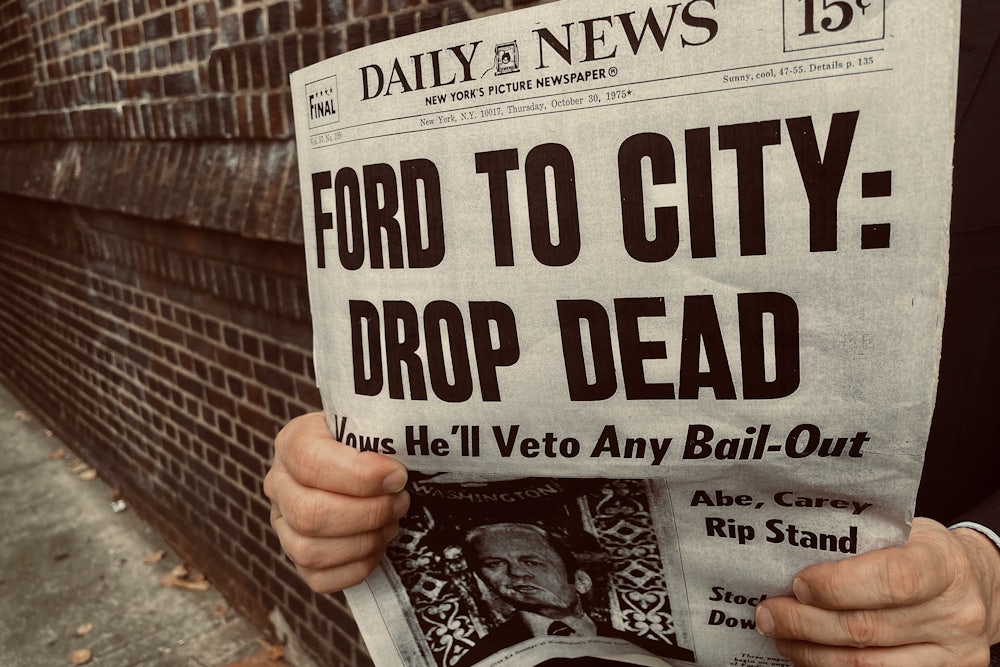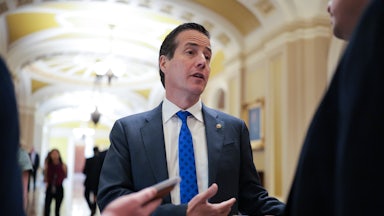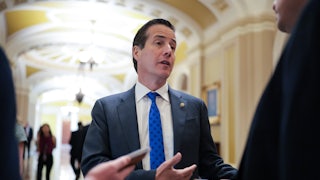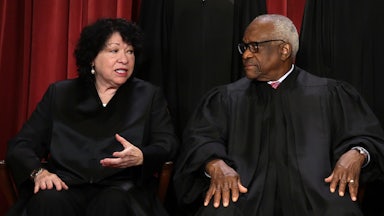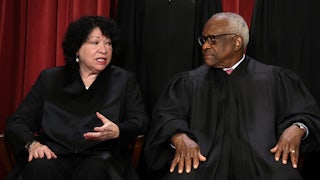Fifty years ago today, the New York Daily News printed what may be the most famous front-page headline that paper has ever produced, consisting of five simple words: “Ford to City: Drop Dead.” The news it was announcing was President Gerald Ford’s decision not to offer a federal bailout to the financially strapped city. But the phrase became shorthand for 1970s New York in general.
Like Howard Cosell’s apocryphal “Ladies and Gentlemen, the Bronx is burning”; like “Fear City,” a tourist pamphlet printed by the police union in the midst of contract negotiations; and like photographs of President Carter standing amid the desolate rubble of Charlotte Street in the South Bronx, “Ford to City: Drop Dead” evokes a mood of disaster and failure. In addition to communicating the temporal fact of Ford’s refusal of Mayor Abe Beame’s bailout entreaty, it also captured a visceral feeling—a sense that New York was doomed.
Fifty years later, it’s worth considering what separates that city from the one again in the crosshairs of an unsympathetic White House. This time it’s the city’s immigrants, not its debts, the president wants to be rid of.
With New York poised to elect its first immigrant mayor since William O’Dwyer, President Trump posted an AI video of himself at the controls of a fighter plane dropping excrement on Gotham. This is Trump to City: Drop Dead—itchy to send in the National Guard and round up our neighbors.
At first, Ford didn’t understand the importance of this most and least American of cities. He resented its cosmopolitanism and swagger, considered its high union wages, public university system, and expansive network of public hospitals and clinics profligate. But Ford was made to understand that if New York reneged on its debt, cities clear across the Rust Belt would tumble too. That’s because commission-chasing bond brokers had for years been selling mayors from Pittsburgh to Milwaukee on the idea they could use municipal bonds to replace the public revenue they lost when factories slunk off to low-wage states.
So, three weeks after the famous headline, the White House did come to New York’s aid, providing $2.3 billion in a series of short-term loans. The city’s unions had already pledged their members’ retirement funds to buying up the restructured debt, creating a public market where the private had failed.
Bankruptcy was averted, but New York changed dramatically. The city that emerged from the fiscal crisis was meaner. As Kim Phillips Fein documented in her excellent book Fear City: New York’s Fiscal Crisis and the Rise of Austerity Politics, by the time of the 1977 blackout, 67,000 city workers would lose their jobs. Scores of city-run day cares closed. Introduction of tuition at the City University of New York drove enrollment down 25 percent.
Subway breakdowns tripled; drug treatment and lead poisoning clinics shuttered; schools cut arts, music, sports, and after-school clubs, and they actually shortened the school day. Around 1,500 firefighters were laid off, and hundreds of cops. By 1977, it was a city of resentment and anger, its finances run by an unelected board of bankers. Donald Trump is a creation of that cruel fiscal crisis city. He got his first public handouts from the state-sponsored Urban Development Corporation, desperate to bring economic activity back to Midtown.
New York City didn’t fall apart just in 1975 or only under the budget shenanigans of Mayors Beame and John Lindsay. Decades of bad ideas had nearly killed New York: running highways through living neighborhoods, luring the middle class to segregated suburbs on subsidized mortgages, chasing industry away in favor of gleaming but tax-abated and often empty office towers, closing firehouses as fires became common, seeding insurance practices that incentivized landlord arson. It wasn’t just the jobs that left: New York’s population dropped by nearly a million people from 1970 to 1980.
The city crawled back during the Mayor Ed Koch years, recovering with a variety of means, including the Wall Street bubble of the 1980s. But the city as experienced by those who weren’t Michael Milken lost its gaunt and haunted feeling only as the population recovered. This was driven by the arrival of new immigrants from the world over. The bedrock optimism of these new immigrants replaced the denuded rubble-scape of the 1970s with a polyglot global metropolis.
Feet from where Carter stood in dismay in the South Bronx, a commercial strip helmed by Dominicans, Yemenis, Mexicans, and Ghanaians now bustles. It was the immigrants who revived the city. Throughout the 1980s and early ’90s, they moved into neighborhoods the city fathers had counseled abandoning—indeed, in a 1976 New York Times Magazine piece, former Housing Commissioner Roger Starr had suggested the city might need to consider “planned shrinkage.”
Innocent of the broken history, agnostic to the heartbreaks in those ruins, the new immigrants came because the battered places were cheap. They filled them up like pine saplings sprouting after forest fire. They asked for little, and, under the anemic social contract of the restructured city, they got little. But by 1990, immigrants made up 29 percent of the city’s population, and 40 percent of its business owners. Factories closing and flight to the suburbs had starved New York. The new immigrants fed the city, paying billions in income and sales tax, populating its parks, and filling it with new rhythms, flavors, and families. It became a safer city as it became again a more immigrant city.
The New York that died in the fiscal crisis was the city inherited from nineteenth-century immigrants, their muscular unions, their instinctual collectivity. The new immigrants operated in a different way: entrepreneurial, independent. Today immigrants like those near Charlotte Street own 47 percent of the small businesses in the city and 62 percent of the restaurants, groceries, nail salons, barber shops, and bodegas that fill our neighborhoods.
Immigrants continue to literally build New York: The construction industry—from laborers to engineers—is 61 percent foreign-born, and about two-thirds of those are undocumented. People who came to New York from another country now make up 37 percent of the city’s population, responsible for more than a third of the economic activity. Undocumented immigrants alone pay $3 billion in sales, property, and business taxes, according to an analysis by the Immigration Research Initiative, a nonpartisan economic think tank. If just one in 10 undocumented New Yorkers are deported or detained, an IRI analysis found, New York State would lose $310 million in state and local taxes. Trump understands this about as well as Ford comprehended the bond market. If ICE empties the now bustling streets, New York will return to those bad old days of stunted economy and haunted blocks.
Donald Trump is a gauche Frankenstein monster whom New York built with public money when it feared its best days were over. But it wasn’t the glitz of Midtown that carried New York from Drop Dead to post-Covid. It was the New Yorkers who never stopped fighting for their neighborhoods and the immigrants whose arrival was new breath.
Those immigrants and their American-born children know from their rugged journeys here, their early mornings rolling up the metal shop gates and their late nights on buses home from second jobs, that conditions can be bad and get better. They’ve put their faith in Zohran Mamdani, believing it possible that the city they revived can be more livable, that the time has come to reclaim some of what was surrendered 50 years ago. Trump, a creature of the old doomed city, doesn’t know the strength of this polyglot, multiracial, hustling new New York. He knows only that cruelty thrills his supporters—and the detention camp shareholders. Even before freezing rent or funding childcare, it is both a moral and an economic necessity that the next mayor protect the people who brought the city back from the brink.
